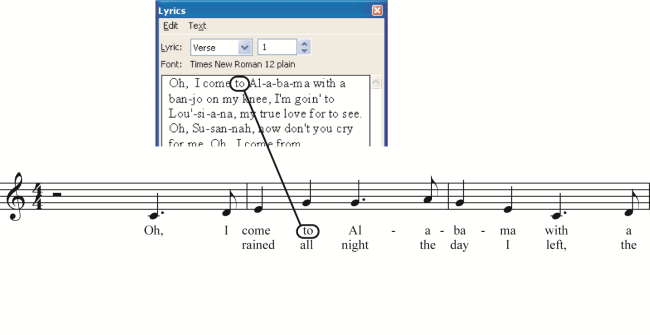Note. View the Using the positioning triangles QuickStart Video for a demonstration of how to use the positioning triangles.
If you make a mistake, just BACKSPACE over it by pressing BACKSPACE. (If you BACKSPACE to the previous syllable, Finale highlights the whole syllable so that you can replace it all at once with anything you type.) To change a word you’ve already typed, click in the staff so that the syllable is highlighted, and then type its replacement. Or, you can change the text in the Lyrics window.
If you encounter a melismatic passage, where one syllable is sustained through several melody notes, press the space bar for each note of the melisma; the cursor will skip ahead to the next note and a word extension will appear for the duration of the melisma.
As you type, Finale stores each syllable in its built-in text processor, the Lyrics window. It’s important to understand that the Lyrics window and the lyrics in the score are dynamically linked. If you change a syllable in the Lyrics window, every occurrence of the syllable is automatically changed in the score—and vice versa.


Notice the syllables you type also appear in the Lyrics window. You can also use the Lyrics window to make changes to the font, style, or size of lyrics. Also, once Lyrics appear in the Lyrics window, they can be click-assigned anywhere in the score. (See To place lyrics into the score (click assignment).)
Note. When you enter lyrics using this method, pay special attention when entering additional lyric lines, one beneath another. To add a new lyric line, be sure to change Verses before typing in each new line; to do so, from the Lyric menu, choose Specify Current Lyric. Otherwise, Finale will believe that all the lyrics, even successive lines, are all part of the same “verse,” and unexpected results may occur.
Tip. if you want a
quick MIDI audio check of the notes you’re attaching lyrics to, hold down
| User Manual Home |

|